Creative Bookshelf Ideas to Enhance Your Home Design
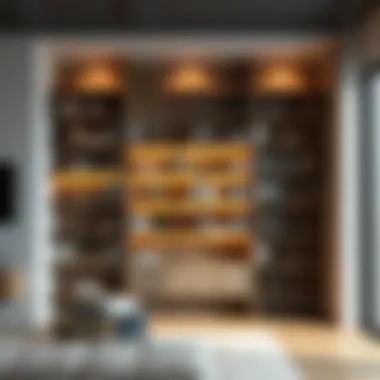
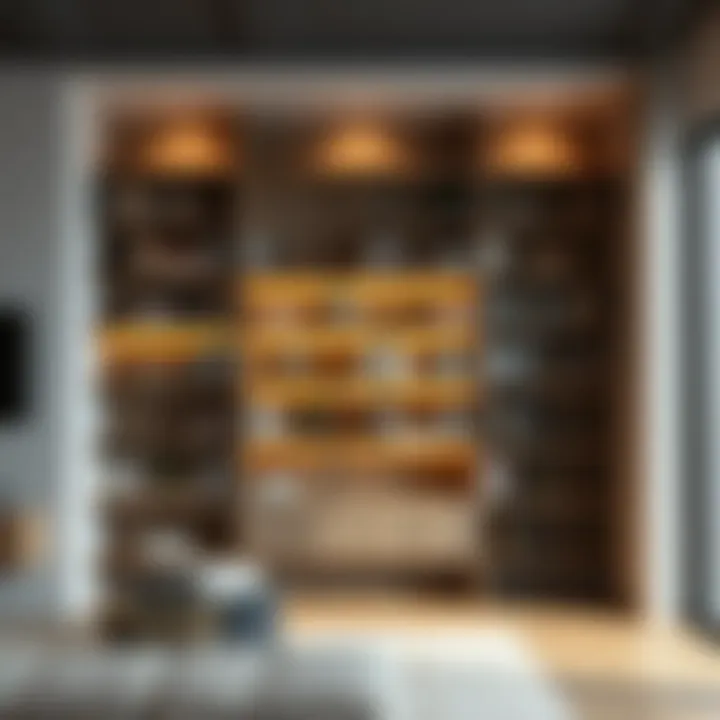
Intro
Bookshelves are more than just practical storage units for holding countless tomes; they have blossomed into essential design elements that can breathe life into any room. Homeowners are increasingly discovering that a thoughtfully styled bookshelf can shift the focus of a space, culminating in breathtaking visual narratives rather than mere collections of books. In a world where blending functionality with aesthetics has become the gold standard in interior design, bookshelves certainly take the spotlight.
As we delve into the multifaceted aspects of bookshelves, we will investigate how to turn them into striking features that captivate and inspire. From various designs that resonate with diverse tastes to the perfect color palettes that enhance any room, this guide aims to empower both design enthusiasts and novices alike. With everything from tips on maximizing storage to the psychological perks of a well-organized bookshelf, a treasure trove of ideas awaits.
It's time to roll up your sleeves and get ready to re-imagine your space! Let's venture into the depths of Design Inspiration where the foundation of stylish bookshelves lies.
The Evolution of Bookshelves
The significance of understanding the evolution of bookshelves cannot be overstated. As we move further into an age where design and function intersect, it helps to trace the journey these once-simple storage units have taken. Bookshelves were once seen merely as practical items—made to hold books and keep clutter at bay. However, they've also transformed into critical design elements that shape the very aesthetics of a space. Each era’s treatment of bookshelves reflects broader cultural and technological shifts, highlighting the interplay between storage and art. This exploration will help homeowners, interior design enthusiasts, and anyone looking to spruce up their living spaces see bookshelves not just as functional tools, but as opportunities for creativity and personalization.
Historical Perspective
Bookshelves have a rich history that dates back to ancient civilizations. In ancient Rome, shelves were often integrated into the architecture of homes, serving to display scrolls and important documents. These early book repositories were basic, often constructed from wood or stone, and not designed for aesthetic appeal. The intent was to store knowledge and keep it accessible to the literate elite of the time.
As centuries passed, the concept of bookshelves evolved alongside the growth of literacy and the availability of printed materials. The Renaissance brought a flourish of creativity, ushering in intricately designed bookshelves made from fine woods, adorned with carvings and inlays. They became symbols of status for the well-educated, reflecting the owner's taste and intellectual pursuits.
In the Victorian era, bookshelves morphed again, becoming lavish pieces of furniture often built into elaborate home libraries. This trend emphasized the growing importance of personal libraries as a status symbol and a reflection of one’s identity. Today, we witness a resurgence of interest in classic designs, with modern interpretations echoing these historical styles while integrating contemporary materials and techniques.
Modern Interpretation
Fast forward to the 21st century, and bookshelves have taken on a new life, blending seamlessly into diverse interior design themes. No longer just square boxes holding tomes, modern bookshelves come in various shapes, sizes, and materials, offering a myriad of choices for any design palate.
Today, we observe several prevalent trends in bookshelf design:
- Open Shelving: This style champions minimalism and encourages creativity in how books and decorative items are displayed, enhancing visual interest while maintaining functionality.
- Geometric Shapes: A nod to modern art, geometric shelving creates a sculptural effect, making the bookshelf itself a statement piece in the room.
- Mixed Materials: Use of metal with wood or glass adds a contemporary edge. For instance, combining reclaimed wood with metal framing can yield a rustic yet chic look that fits into many decors.
Modern bookshelves also prioritize function beyond just storage. They often serve as room dividers or even as integrated units with built-in desks or seating. With the rise of urban living, these innovative designs are crucial in maximizing limited space while injecting unique style into homes.
As we delve deeper into the innovative ideas surrounding bookshelves, it’s important to appreciate the journey that has brought them to where they are today—essential elements of home décor that tell a story about the owner and their space.
Types of Bookshelves
Bookshelves are much more than mere storage units for your favorite tomes; they serve as a pivotal element in interior design. Each type of bookshelf caters to different needs and aesthetics, allowing homeowners and design enthusiasts to select the best fit for their spaces. The considerations in choosing the right type can influence not just the functionality, but also the overall vibe of a room. Varieties such as freestanding shelves, wall-mounted units, and built-in options all come with distinct advantages that can transform a living area, office, or any cozy nook into a stylish and organized space.
Freestanding Shelves
Freestanding shelves often act as a room's statement piece. Their versatility allows them to stand alone without being attached to walls, which means they can be repositioned as desired. Not only are they functional, but they also add character to any room.
- Movement: The ability to relocate them from room to room offers an opportunity for homeowners to refresh their living spaces without a complete overhaul.
- Variety of Designs: They come in multiple styles, from minimalist frames to ornate detailing, accommodating various tastes. This allows for a seamless blend with existing decor.
- Capacity: Freestanding bookshelves can often accommodate a larger number of books and decorative items, providing a canvas for creativity.
However, positioning these shelves requires thoughtful consideration regarding scale, especially in smaller rooms. When utilized strategically, they can create a sense of height and spaciousness while serving as an organized space for beloved collections.
Wall-Mounted Units
Wall-mounted bookshelves have become increasingly popular in modern interiors due to their clean lines and space-saving advantages. These units are bolted into a wall, making them an intelligent choice for maximizing vertical space.
- Space Efficiency: Ideal for compact living environments, wall-mounted units help maintain floor space, a crucial factor for apartment dwellers and those with smaller homes.
- Visual Impact: They often create a floating illusion, giving an airy feel to a room. This effect can make views seem unobstructed while highlighting featured books or decorative items.
- Customization: Available in various shapes and designs, wall-mounted units can be tailored to fit unique spaces, such as corners or even spaces above furniture.
On the downside, installation could be a hurdle, requiring drilling and potentially some carpenter expertise.
"Wall-mounted units can turn even the most mundane room into a sophisticated reading nook."
Built-in Options
Built-in bookshelves seamlessly blend into the architecture of a home, providing a bespoke feel that other types cannot match. These options are often custom designed to fit specific spaces, enhancing both aesthetics and practicality in truly unique ways.
- Integration with Existing Structures: Built-ins can be designed to wrap around windows or fill recesses, making them feel like a natural part of the house rather than a separate entity.
- Enhanced Value: A thoughtfully constructed built-in bookshelf can increase the overall value of a property, appealing to potential buyers who appreciate both utility and design.
- Personalization: Homeowners can truly express their design style by selecting finishes, colors, and styles that resonate with them, thus creating a unique focal point.
However, while they can provide significant benefits, built-ins can also require a higher initial investment and longer installation time compared to other types of shelves.
Selecting the right type of bookshelf is an art form of its own, and the choice should not be taken lightly. Each type not only serves a purpose but also significantly influences the atmosphere of a room, ensuring that the right decision can lead to a beautiful and organized living space.
Materials and Finishes
When it comes to designing bookshelves, the choice of materials and finishes cannot be overlooked. They play a crucial role in defining the overall aesthetic and functionality of the storage unit. The right materials can transform a simple shelf into a statement piece, while also ensuring durability and practicality. Choices in materials carry different implications for upkeep, weight capacity, and room ambiance. Homeowners, interior design enthusiasts, and anyone invested in their living spaces should consider both the visual appeal and the contextual suitability of materials when selecting bookshelves.
Wood: Classic and Versatile
Wood has long been a staple in bookshelf construction, valued for its enduring quality and natural beauty. Highly sought after are hardwoods like oak, walnut, and cherry, known for their rich textures and stunning grain patterns. Each piece of wood tells its own story through the knots and lines, bringing a unique character to any space. With different finishes available, from rustic stains to sleek lacquers, wooden bookshelves can complement a variety of interior styles from farmhouse to modern minimalism.
Considerations for using wood include its maintenance. Wood can require routine care, such as polishing or conditioning to maintain its luster. However, this is often a small price to pay for a classic material that ages gracefully.
- Pros of Wood Bookshelves:
- Cons of Wood Bookshelves:
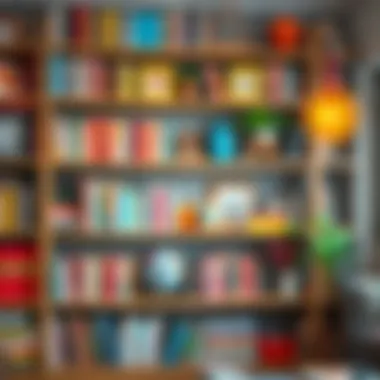
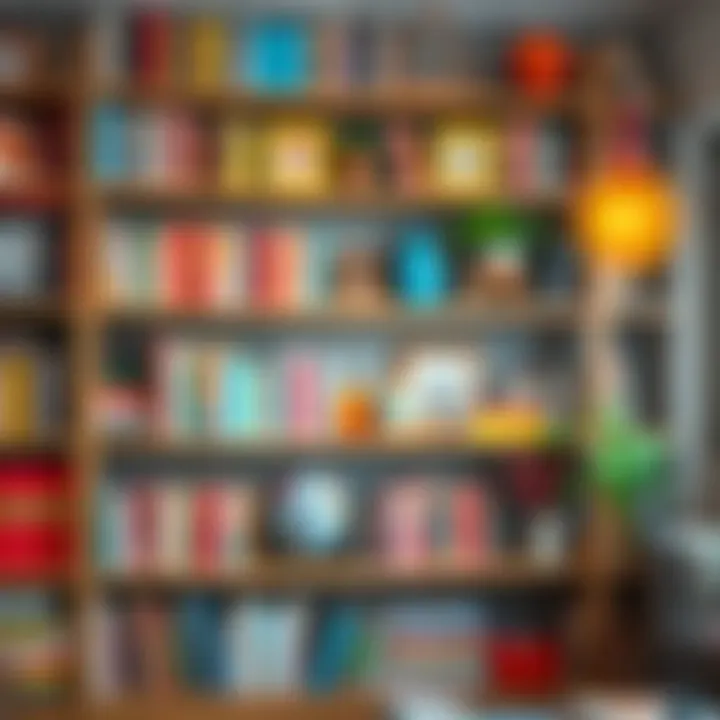
- Timeless elegance
- Warmth and texture
- Ease of customization
- Requires maintenance
- Can be heavy and bulky
Metal: Industrial Chic
Metal bookshelves offer a striking contrast to wooden units, often bringing an industrial chic vibe into a home. With finishes ranging from polished stainless steel to rusted iron, metal shelves can be as robust as they are stylish. This material transcends trends; it has a certain permanence that can withstand the test of time. While metal shelves might lend themselves well to contemporary or minimalist designs, with the right touches, they can integrate seamlessly into eclectic environments too.
However, one should be mindful of metal’s weight. Heavier than wood or glass, all-metal constructions may require reinforcement when mounted. Moreover, while metal can be resilient, it may also dent more easily than wood.
- Pros of Metal Bookshelves:
- Cons of Metal Bookshelves:
- Durability and strength
- Modern aesthetics
- Low maintenance requirements
- Can be heavy and require sturdy installation
- Potential for rust if exposed to moisture
Glass: A Study in Transparency
Glass bookshelves can add an air of lightness and modernity to a room. They create an illusion of space, making them ideal for smaller areas where you want to maximize the feeling of openness. Glass units can either be fully transparent, showcasing the books and decorative items you choose to display, or frosted for a softer, more diffused look.
While aesthetically pleasing, glass isn’t often as practical for heavy loads compared to wood or metal. It’s essential to consider the weight of the items you plan to store. Furthermore, glass requires frequent cleaning to avoid fingerprints and smudges, making it a less practical choice for families with children or pets.
- Pros of Glass Bookshelves:
- Cons of Glass Bookshelves:
- Sleek and modern look
- Enhances space without overwhelming it
- Compliments other materials very well
- Fragility and risk of breakage
- Higher maintenance for cleanliness
In sum, the choice of materials and finishes significantly impacts not just the style, but the practicality of your bookshelf design. Selecting the right one is akin to choosing the frame for a masterpiece—you want to elevate the art while ensuring lasting function.
Integrating Bookshelves into Design Themes
Integrating bookshelves into various design themes is crucial for any homeowner or design enthusiast looking to create a cohesive, stylish environment. Bookshelves serve as much more than a place to house books; they reflect personal interests and tastes while enhancing the overall aesthetic of a room. Understanding how to blend bookshelves with the decor can transform a plain space into something truly unique.
Designing with bookshelves in mind involves several key considerations: matching colors, selecting complementary materials, and aligning with the room's intended atmosphere. These factors all contribute to an inviting space where functionality meets style. Bookshelves can act as focal points or seamlessly integrate into the background, depending on how they are arranged and styled.
There are various approaches to designing with bookshelves:
- Visual Cohesion: Ensure that the style of the bookshelf complements surrounding furniture and decor.
- Personal Touches: Use bookshelves to display items that reflect your personality, like unique collectibles, art pieces, or family photos.
- Functionality: Consider your lifestyle when selecting designs—do you need space for novels, decor, or perhaps board games?
In this section, we will delve deeper into specific design themes that successfully incorporate bookshelves, starting with minimalist aesthetics.
Minimalist Aesthetics
Minimalism, at its core, embraces simplicity and functional design. When integrating bookshelves into minimalist spaces, less is often more. The idea is to create a clean, uncluttered environment that emphasizes openness and serenity. Think sleek lines, muted colors, and the absence of excess.
- Variations on Height: Floating shelves that stretch horizontally can create the illusion of more space, while tall, narrow bookshelves add verticality without overwhelming the room.
- Neutral Palette: Using light woods or white-painted finishes reduces visual clutter and allows the eye to flow seamlessly through the space.
- Minimal Display: Limit the items displayed on the shelves to foster a serene atmosphere. Perhaps a single hardcover book with an elegant vase beside it will suffice.
Eclectic Styles
An eclectic design theme celebrates the art of mixing and matching different elements that don’t seem to go together on paper but blend beautifully in practice. When crafting an eclectic bookshelf scene, the sky's the limit.
- Unexpected Combinations: Marry bright colors with rustic wood or ornate metallics. This allows for more room to reflect your quirks and interests.
- Layering Textures: Utilize materials like wicker baskets, prints, and ceramics to create a dynamic visual experience. Each texture adds its own dimension while keeping the eye engaged.
- Curated Collections: Showcase odd knick-knacks or collections—think vintage cameras or foreign souvenirs. These personal items can evoke stories and memories.
Traditional Interiors
Traditional design often symbolizes enduring elegance. To integrate bookshelves in a traditional setting, consider incorporating ornate details and classic finishes.
- Rich Mahogany or Oak: Stick with rich, dark woods that echo historical craftsmanship and warmth. Bookshelves here can serve as architectural elements, molding to the wall.
- Rich Fabrics and Patterns: Use decorative backs or wallpaper within the shelves to add a touch of sophistication. Think damask or floral patterns that harken back to classic design.
- Symmetrical Arrangements: Keep the layout balanced with equal spacing and symmetrical shelving for a more dignified appearance.
Contemporary Spaces
In contemporary design, bookshelves can break free from traditional notions of form and functionality. It's about exploring new shapes and lines that invite creativity.
- Geometric Shapes: Look for bookshelves that feature asymmetry or varied geometric designs that uplift the aesthetic appeal.
- Open Shelving: Instead of hiding books behind doors, display them openly to create an airy effect and encourage social interaction around them.
- Integrated Lighting: Consider bookshelves with built-in lighting or accent lighting that elevates what's stored within. When displayed properly, items can shine beautifully.
Integrating bookshelves into different design themes is an art unto itself. Whether opting for minimalist, eclectic, traditional, or contemporary styles, taking the time to think about how the bookshelf interacts with the rest of the space is paramount. As you navigate through the various possibilities, the bookshelf can truly become a hallmark of your home.
Functionality Beyond Storage
When one thinks of bookshelves, the first image that comes to mind is often a simple unit meant to hold a collection of books. However, the scope of modern bookshelves goes far beyond just housing literature. In contemporary interior design, these pieces are taking on multifaceted roles, transforming them into essential elements that enhance both aesthetics and functionality.
Understanding the versatility of bookshelves is crucial for homeowners, interior design enthusiasts, and even those who just want to optimize their living spaces. By looking at how bookshelves can serve as decoration, space dividers, and organizational tools, you can greatly enhance the appeal of any room.
Display and Decoration
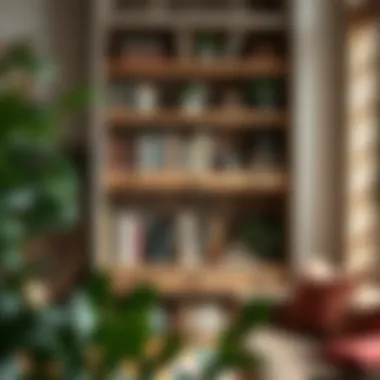
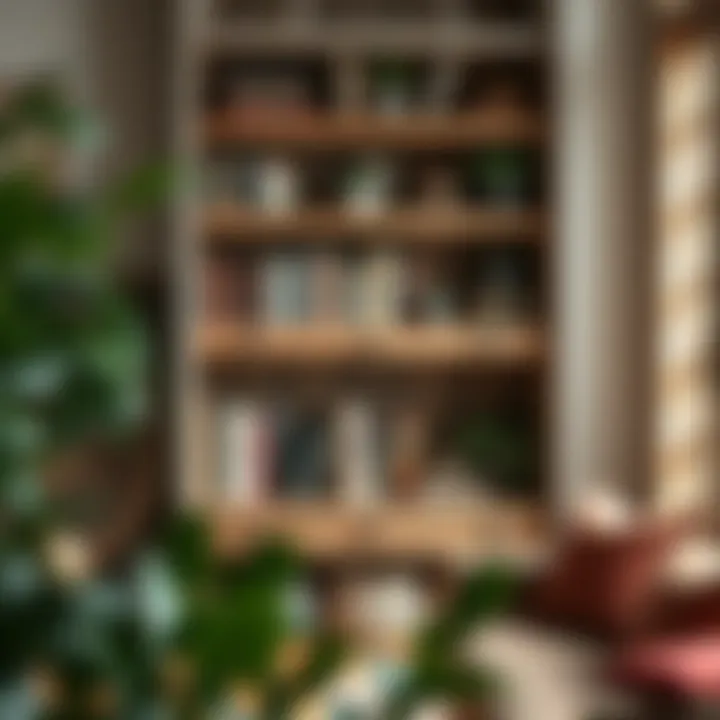
Bookshelves can act as more than just functional items; they can serve as vital showcases for personal expression. Imagine a living room where sleek, contemporary shelving holds not only books but also curated art pieces and family photos. This mix creates a visually stimulating environment.
To effectively utilize a bookshelf as a display surface, consider:
- Layering: Place items at varying depths. For instance, a few smaller books placed in front of larger tomes creates a visually intriguing look.
- Color Coordination: Grouping books and decorations by color can turn a simple shelving unit into a striking feature.
- Unique Odds and Ends: Incorporate plants, sculptures, and other non-book items to create an inviting atmosphere that reflects your personality.
"A well-decorated bookshelf tells a story—yours. It’s an insight into who you are beyond mere titles and authors."
With thought and creativity, a bookshelf can be a conversation starter that reveals your interests and ethos.
Room Dividers
In open concept living areas, using bookshelves as room dividers is a clever way to define spaces without compromising the flow of natural light. A strategically placed bookshelf can create a visually appealing partition that delineates the living area from a study or dining area.
Here are a few tips to consider for making the most of a bookshelf as a room divider:
- Height Matters: Opt for taller shelves if you’re looking for a more substantial division between spaces. Lower shelves can maintain an airy feel.
- Backless Options: A backless bookshelf can provide separation while still allowing light to pass through, keeping the space bright.
- Mix and Match: Combine different shelving styles to create a dynamic feel. For example, you can use a wooden shelf paired with a metal frame, contributing to an eclectic vibe.
This functionality allows for a seamless blend of personal space and common areas, making it ideal for apartments, studios, or homes with multiple users.
Organization and Accessibility
One of the practical merits of a well-designed bookshelf is its role in organization. Bookshelves offer a systematic way to keep your surroundings tidy and accessible. An organized shelf not only looks good but also saves time.
To maximize the organizational aspect of your bookshelves, consider these strategies:
- Categorization: Group books by genre, author, or even color. This not only adds a personal touch but makes finding a book easier.
- Use of Baskets and Bins: Incorporate decorative baskets or bins for smaller items that are otherwise hard to manage. This adds an element of decor while keeping clutter at bay.
- Labeling: For extensive collections, labeling shelves can quickly guide guests or family members to the right spots, making accessibility a breeze.
By recognizing these elements, bookshelves evolve into vital components of your living space, marrying style with function effortlessly. Assessing how to integrate these features into your design will elevate your home’s interior, making it more than just a place to live—rather, a reflection of who you are.
Aesthetic Arrangements
When it comes to bookshelves, the visual presentation is as critical as their functional role. Aesthetic arrangements offer a way to express personal style while ensuring the bookshelves don't merely serve as storage but shine as focal points in a room. The thoughtful placement of books, decor items, and art can create harmony and balance, making spaces feel welcoming and carefully curated.
Symmetry vs. Asymmetry
Choosing between symmetry and asymmetry is often the first step in arranging a bookshelf. Symmetrical arrangements are all about balance. They often feature books stacked in pairs, evenly spaced decor pieces, and decorative items that mirror each other across the shelf. For instance, two identical vases flanking a stack of books can make for a cohesive and pleasing look. This kind of arrangement works wonderfully in more traditional or minimalist designs, where clean lines and orderly patterns reign supreme.
On the other hand, asymmetrical arrangements embrace a more dynamic approach, allowing for creativity and personal flair. Picture a shelf with various items of different heights and shapes, creating visual interest through contrast. For example, a tall sculpture on one end, balanced by shorter books and eclectic trinkets on the other, can engage the eye and spark conversation. This style appeals to those who enjoy a more eclectic or contemporary aesthetic, inviting an air of spontaneity into their interiors.
"The beauty of bookshelves lies not just in their contents but in how those contents are presented."
Layering Techniques
Layering techniques can elevate the aesthetic of bookshelves, transforming them from ordinary to extraordinary. To layer effectively, think about foreground versus background. Start with larger books or bold-colored items at the back for a solid foundation. Then, introduce smaller books or decorative pieces in front to create depth. This technique provides not only visual interest but also showcases the items in a way that draws the eye.
Using books of varying sizes can serve this layering purpose well. For instance, placing larger coffee table books on the lower shelves while layering in smaller novels on the upper can lead to a striking visual impact. Mixing media also enriches this layering approach; integrating plants, artwork, or sculptural elements alongside traditional books can break up monotony while encouraging a layered aesthetic.
Color Coordination
Color coordination plays a pivotal role in bookshelf aesthetics. A well-coordinated color scheme can unify the various components, creating a polished look. When selecting colors, consider the overall color palette of the room. A monochromatic scheme, where all books are organized by similar shades, can give a clean and modern impression. This method also works effectively in minimalist spaces, where less is often more.
On the flip side, a bright and varied color arrangement can inject energy into a room—think of vibrant spine colors arranged in a rainbow pattern, creating a playful and whimsical display. For those with a penchant for design, integrating decor that either complements or contrasts these colors can enhance the visual allure.
Maximizing Small Spaces
In urban living, where square footage is often a luxury, the importance of maximizing small spaces cannot be overstated. Bookshelves, traditionally viewed simply as storage, can evolve into creative and impactful components of interior design. Not only do they hold literature, but they also serve as focal points that can enhance the overall aesthetic of a room.
By planning thoughtfully, you can not only store your books but also integrate style and personality into your environment.
Utilizing Vertical Space
When space is tight, going vertical is a smart move. Instead of traditional, horizontal shelving, consider tall bookshelves that draw the eye upward. This approach not only takes advantage of often-overlooked wall space but also creates an illusion of height, which can make a room feel larger.
Here are several ideas to think about:
- Tall Bookcases: Opt for slender, towering bookcases that can fit snugly in corners or beside doorways. They maximize storage without intruding on floor space.
- Floating Shelves: These are a winner in any small space. Floating shelves can hold more than books; use them for decorative items, potted plants, or family photos. This builds layers without taking up precious floor area.
- Over-the-Door Racks: These clever contraptions can hold books, magazines, or decorative baskets without using any floor space at all. It's a simple trick that packs a punch in functionality.
Utilizing vertical space frees up your room and creates a sense of organized serenity, perfect for anyone feeling cramped or overwhelmed by clutter.
Multi-Functional Designs
With small spaces, dual-purpose designs come to the forefront as practical solutions that harmonize utility and style. When bookshelves serve more than one purpose, they can dramatically alter the dynamics of a room.
Consider these multi-functional designs:
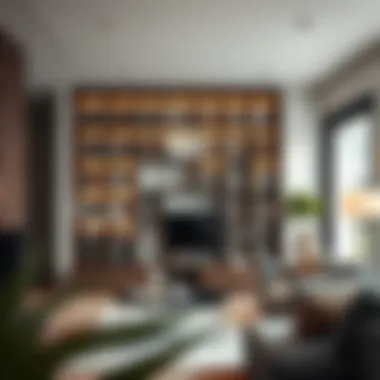
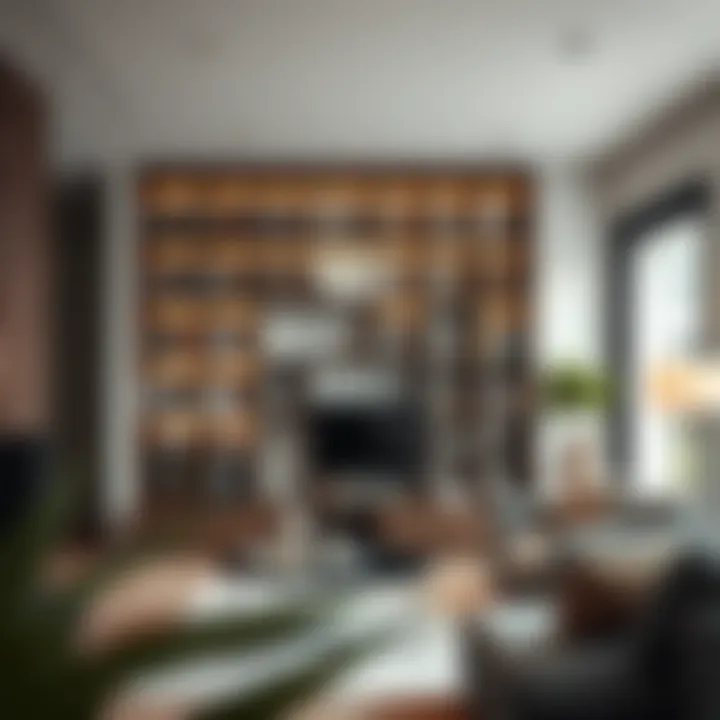
- Bookshelf with a Workspace: For those who work from home or need a study nook, integrating a small desk within or adjacent to a bookshelf can create a seamless workflow. This arrangement not only provides efficient storage but also keeps everything you need within arm’s reach.
- Coffee Table and Bookshelf Combo: A coffee table with an integrated bookshelf can be perfect for living rooms where you wish to maximize functionality while maintaining a stylish appearance. It's a unique conversation starter and practical at the same time.
- Bench with Storage: Benches that incorporate bookshelves beneath are great for entryways or living areas, inviting seating while giving you a space to showcase books or other decorative elements.
Employing multi-functional designs enables you to create an environment that feels both spacious and inviting. It reflects not just an understanding of space but a keen sense of style that saturates your home with charm and character.
Using bookshelves to maximize space is about creativity. Think outside the box, and your storage can enhance your living space!
By incorporating these innovative ideas into your home, you transform bookshelves from just mere storage units to stylish and functional elements that reflect your lifestyle and tastes.
Psychological Benefits of Organized Spaces
In the hustle and bustle of our daily lives, the spaces we inhabit can often feel chaotic and overwhelming. Yet, having an organized space, particularly when it comes to something as ubiquitous as bookshelves, can significantly enhance our mental well-being. The relationship between our environment and our psychological state is profound. When bookshelves are not just functional but thoughtfully arranged, they can contribute to a sense of tranquility and order, providing benefits that extend beyond the mere aesthetics of a room.
One of the first advantages of an organized bookshelf is its impact on stress reduction. Clutter has been shown to increase feelings of anxiety and distraction. By keeping your books and decorative items in an orderly manner, you can foster a calmer atmosphere in your home. A neat bookshelf acts almost as a silent retreat, inviting you to engage with your favorite reads or make the space more inviting for others.
Considerations include:
- Regular upkeep of your bookshelf can prevent clutter from accumulating
- Create sections by genre or color to enhance visual appeal
- Involve family members or roommates in the organization process
Organized spaces can also boost productivity. Imagine trying to work or study in an area where distractions abound – it becomes nearly impossible to concentrate. A bookshelves system that categorizes titles efficiently allows for smoother transitions between tasks. The focus is on interaction with materials rather than on the struggle to find them.
Impact on Focus and Productivity
The layout and organization of a bookshelf can heavily influence focus and productivity, especially in a work-from-home environment. When your books and resources are easily accessible and clearly visible, the cognitive load required to locate and manage them diminishes.
Think about color coordination or thematic arrangements – they don’t just create a visually striking display, they also serve a functional purpose. For instance, if a person is working on a research project, having related books all in one section aids in quick retrieval, reducing the time spent searching. By designing bookshelves with usability in mind, you enhance not only the functionality but also the overall mood of the workspace.
- Create clear labels for different genres or subjects
- Limit the number of books on display to avoid overwhelming visual clutter
- Consider adjustable shelving for flexibility as your collection grows
Additionally, studies suggest that visual cues play a critical role in our decision-making processes. With a well-arranged bookshelf providing constant reminders of what you want to engage with, it becomes simpler to stay focused.
Enhancing Creative Environments
Bookshelves can serve as catalysts for creativity. When a space is organized and visually appealing, it invites inspiration. Clutter can stifle creativity, making it hard to think outside the box. By keeping bookshelves tidy and full of diverse resources, you foster a space that encourages new ideas and perspectives.
A creative environment benefits from elements of surprise - an art piece nestled between books, a plant peeking from behind a title, or even interesting trinkets collected from travels. These elements not only personalize the shelf but also stimulate the mind.
Moreover, bookshelves can display creative works, serving as a backdrop for inspiration. Artists and writers often find that motivation can ebb and flow. In times of block, a glance at a bookshelf that showcases beloved works or personal achievements can spark a new wave of ideas.
- Implement mixed-media displays: pair books with artwork or plants
- Regularly rotate displayed items to keep the environment fresh
- Use light creatively, such as adding fairy lights or task lamps to highlight certain areas
Ultimately, an organized bookshelf isn’t merely a storage solution; it’s a bridge to enhanced focus, productivity, and creativity. By paying attention to the arrangement and purpose of these shelves, we can create a more effective and inspiring environment, making the ordinary extraordinary.
Sustainable Practices in Bookshelf Design
In today’s world, the push for sustainability is growing stronger every day. Incorporating this ethos into bookshelf design not only benefits the planet but also lends an innovative flair to your space. Homeowners and interior aficionados alike are increasingly aware of how their choices impact the environment, making sustainable bookshelf practices a vital topic. It’s no longer just about having a place to stash books; it’s about creating beautiful, eco-friendly design elements that reflect a commitment to responsible living.
Eco-Friendly Materials
When considering sustainable practices, the choice of materials speaks volumes. Rather than opting for conventional wood sourced from unsustainable logging, consider alternatives like bamboo or reclaimed wood. Bamboo, being one of the fastest-growing plants on Earth, is a superb candidate because it regenerates quickly without the need for replanting. Furthermore, reclaimed wood not only reduces waste but also carries a unique character that adds depth to your bookshelves.
Additionally, look into materials like recycled metal and glass. These add a modern touch while promoting a circular economy, ensuring that resources aren't wasted. Employing low-VOC finishes is another vital consideration. Such finishes mitigate harmful chemicals that seep into the air, promoting a healthier indoor environment.
"Choosing with care means not only enhancing the design but also embracing a sustainable future."
Repurposing and Upcycling
The beauty of repurposing is that it turns something old and unused into a stunning centerpiece for your space. An antique ladder, for instance, can make for a visually interesting bookshelf, offering a rustic charm while being practical. Similarly, wooden crates can be stacked and painted to create a custom shelving unit. This move not only saves you money but also reduces waste, making it an exemplar of sustainable design.
When upcycling, the limits are often only in your imagination. Think outside the box. A vintage suitcase can serve as a unique bookshelf, providing both storage and a nostalgic vibe. Old doors can be transformed into stylish shelving, merging functionality with a touch of history.
Two key benefits of repurposing are:
- Uniqueness: Every upcycled piece tells its own story, becoming a talking point in your home.
- Conservation: By giving new life to forgotten items, you contribute to lessening the demand for new resources, reducing the overall carbon footprint.
To sum it up, adopting sustainable practices in bookshelf design not only allows individuals to reflect their values but also encourages creativity and individuality in home design. Whether choosing eco-friendly materials or aiming to repurpose existing items, the journey toward a more sustainable bookshelf is both practical and stylish.
Final Thoughts on Bookshelves
Bookshelves serve a significant purpose beyond mere storage. They stand as testament to personal style, embodying a narrative that reflects individual taste and lifestyle. This final section delves into the vital aspects of transforming bookshelves from functional space savers to striking design features within any home.
From Storage to Style
The transformation of bookshelves into stylish elements isn't just about aesthetics; it’s a deliberate shift in how we perceive and utilize our spaces. By carefully selecting a bookshelf's design, materials, and arrangement, homeowners can create an inviting atmosphere that resonates with creativity.
- Personal Expression: Bookshelves provide an excellent canvas for self-expression. From the choice of colors to the arrangement of books and decor, every element can accentuate one's personality. Strategic placement of cherished items, like potted plants or framed photos, isn’t merely for looks; it helps to tell a unique story that sparks conversation.
- Functional Arrangement: While style is crucial, maintaining an element of functionality shouldn't be overlooked. Consider adjustable shelves or modular units that offer flexibility. The idea is to craft spaces that are both beautiful and practical. All it takes is a little thought to ensure easy access to your favorite reads while still making an artistic impact.
"A bookshelf isn't just a holder of books; it’s a gallery of memories and ideas."
An Ever-Evolving Design Element
In a world where trends come and go, bookshelves remain a steadfast companion to our evolving tastes. They adapt to changes in decor while accommodating lifestyle shifts, whether you’re moving to a bigger space or downsizing to something cozier.
- Sustainability Factor: With the growing trend towards eco-conscious living, bookshelves can be a testament to sustainable choices. Using reclaimed wood or upcycled materials not only enhances the aesthetic appeal but also contributes positively to the planet. It mirrors a lifestyle that values sustainability, blending style with environmental responsibility.
- Future-Proofing Your Space: Investing in timeless designs or versatile pieces ensures that your bookshelves won't feel outdated in a few years. Going for neutral hues combined with classic shapes allows your design to evolve with changing interior styles, meaning less hassle and more harmony.



